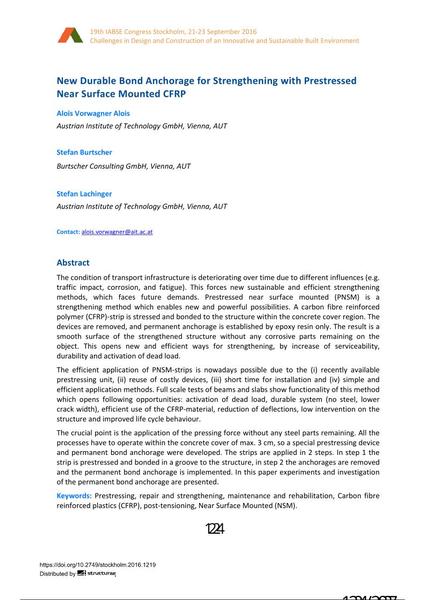New Durable Bond Anchorage for Strengthening with Prestressed Near Surface Mounted CFRP

|
|
|||||||||||
Bibliografische Angaben
| Autor(en): |
Alois Vorwagner
(Austrian Institute of Technology GmbH, Vienna, AUT)
Stefan Burtscher (Burtscher Consulting GmbH, Vienna, AUT) Stefan Lachinger (Austrian Institute of Technology GmbH, Vienna, AUT) |
||||
|---|---|---|---|---|---|
| Medium: | Tagungsbeitrag | ||||
| Sprache(n): | Englisch | ||||
| Tagung: | IABSE Congress: Challenges in Design and Construction of an Innovative and Sustainable Built Environment, Stockholm, Sweden, 21-23 September 2016 | ||||
| Veröffentlicht in: | IABSE Congress Stockholm, 2016 | ||||
|
|||||
| Seite(n): | 1224-1231 | ||||
| Anzahl der Seiten (im PDF): | 8 | ||||
| Jahr: | 2016 | ||||
| DOI: | 10.2749/stockholm.2016.1219 | ||||
| Abstrakt: |
The condition of transport infrastructure is deteriorating over time due to different influences (e.g. traffic impact, corrosion, and fatigue). This forces new sustainable and efficient strengthening methods, which faces future demands. Prestressed near surface mounted (PNSM) is a strengthening method which enables new and powerful possibilities. A carbon fibre reinforced polymer (CFRP)-strip is stressed and bonded to the structure within the concrete cover region. The devices are removed, and permanent anchorage is established by epoxy resin only. The result is a smooth surface of the strengthened structure without any corrosive parts remaining on the object. This opens new and efficient ways for strengthening, by increase of serviceability, durability and activation of dead load. The efficient application of PNSM-strips is nowadays possible due to the (i) recently available prestressing unit, (ii) reuse of costly devices, (iii) short time for installation and (iv) simple and efficient application methods. Full scale tests of beams and slabs show functionality of this method which opens following opportunities: activation of dead load, durable system (no steel, lower crack width), efficient use of the CFRP-material, reduction of deflections, low intervention on the structure and improved life cycle behaviour. The crucial point is the application of the pressing force without any steel parts remaining. All the processes have to operate within the concrete cover of max. 3 cm, so a special prestressing device and permanent bond anchorage were developed. The strips are applied in 2 steps. In step 1 the strip is prestressed and bonded in a groove to the structure, in step 2 the anchorages are removed and the permanent bond anchorage is implemented. In this paper experiments and investigation of the permanent bond anchorage are presented. |
||||
| Stichwörter: |
Vorspannung
|
||||
